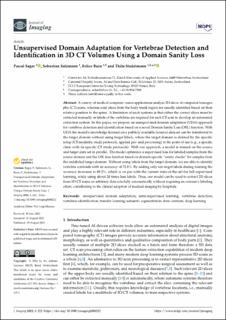Please use this identifier to cite or link to this item:
https://doi.org/10.21256/zhaw-25502Full metadata record
| DC Field | Value | Language |
|---|---|---|
| dc.contributor.author | Sager, Pascal | - |
| dc.contributor.author | Salzmann, Sebastian | - |
| dc.contributor.author | Burn, Felice | - |
| dc.contributor.author | Stadelmann, Thilo | - |
| dc.date.accessioned | 2022-08-25T08:24:31Z | - |
| dc.date.available | 2022-08-25T08:24:31Z | - |
| dc.date.issued | 2022-08-19 | - |
| dc.identifier.issn | 2313-433X | de_CH |
| dc.identifier.uri | https://digitalcollection.zhaw.ch/handle/11475/25502 | - |
| dc.description.abstract | A variety of medical computer vision applications analyze 2D slices of computed tomography (CT) scans, whereas axial slices from the body trunk region are usually identified based on their relative position to the spine. A limitation of such systems is that either the correct slices must be extracted manually or labels of the vertebrae are required for each CT scan to develop an automated extraction system. In this paper, we propose an unsupervised domain adaptation (UDA) approach for vertebrae detection and identification based on a novel Domain Sanity Loss (DSL) function. With UDA the model’s knowledge learned on a publicly available (source) data set can be transferred to the target domain without using target labels, where the target domain is defined by the specific setup (CT modality, study protocols, applied pre- and processing) at the point of use (e.g., a specific clinic with its specific CT study protocols). With our approach, a model is trained on the source and target data set in parallel. The model optimizes a supervised loss for labeled samples from the source domain and the DSL loss function based on domain-specific “sanity checks” for samples from the unlabeled target domain. Without using labels from the target domain, we are able to identify vertebra centroids with an accuracy of 72.8%. By adding only ten target labels during training the accuracy increases to 89.2%, which is on par with the current state-of-the-art for full supervised learning, while using about 20 times less labels. Thus, our model can be used to extract 2D slices from 3D CT scans on arbitrary data sets fully automatically without requiring an extensive labeling effort, contributing to the clinical adoption of medical imaging by hospitals. | de_CH |
| dc.language.iso | en | de_CH |
| dc.publisher | MDPI | de_CH |
| dc.relation.ispartof | Journal of Imaging | de_CH |
| dc.rights | https://creativecommons.org/licenses/by/4.0/ | de_CH |
| dc.subject | Unsupervised domain adaptation | de_CH |
| dc.subject | Semi-supervised learning | de_CH |
| dc.subject | Vertebrae detection | de_CH |
| dc.subject | Vertebrae identification | de_CH |
| dc.subject | Transfer learning | de_CH |
| dc.subject | Semantic segmentation | de_CH |
| dc.subject | Data centrism | de_CH |
| dc.subject | Deep learning | de_CH |
| dc.subject.ddc | 006: Spezielle Computerverfahren | de_CH |
| dc.subject.ddc | 616: Innere Medizin und Krankheiten | de_CH |
| dc.title | Unsupervised domain adaptation for vertebrae detection and identification in 3D CT volumes using a domain sanity loss | de_CH |
| dc.type | Beitrag in wissenschaftlicher Zeitschrift | de_CH |
| dcterms.type | Text | de_CH |
| zhaw.departement | School of Engineering | de_CH |
| zhaw.organisationalunit | Centre for Artificial Intelligence (CAI) | de_CH |
| dc.identifier.doi | 10.3390/jimaging8080222 | de_CH |
| dc.identifier.doi | 10.21256/zhaw-25502 | - |
| zhaw.funding.eu | No | de_CH |
| zhaw.issue | 8 | de_CH |
| zhaw.originated.zhaw | Yes | de_CH |
| zhaw.pages.start | 222 | de_CH |
| zhaw.publication.status | publishedVersion | de_CH |
| zhaw.volume | 8 | de_CH |
| zhaw.publication.review | Peer review (Publikation) | de_CH |
| zhaw.webfeed | Machine Perception and Cognition | de_CH |
| zhaw.webfeed | Datalab | de_CH |
| zhaw.webfeed | Digital Health Lab | de_CH |
| zhaw.webfeed | ZHAW digital | de_CH |
| zhaw.author.additional | No | de_CH |
| zhaw.display.portrait | Yes | de_CH |
| Appears in collections: | Publikationen School of Engineering | |
Files in This Item:
| File | Description | Size | Format | |
|---|---|---|---|---|
| 2022_Sager-etal_Unsupervised-domain-adaptation-vertebrae-detection-3D-CT.pdf | 32.91 MB | Adobe PDF |  View/Open |
Show simple item record
Sager, P., Salzmann, S., Burn, F., & Stadelmann, T. (2022). Unsupervised domain adaptation for vertebrae detection and identification in 3D CT volumes using a domain sanity loss. Journal of Imaging, 8(8), 222. https://doi.org/10.3390/jimaging8080222
Sager, P. et al. (2022) ‘Unsupervised domain adaptation for vertebrae detection and identification in 3D CT volumes using a domain sanity loss’, Journal of Imaging, 8(8), p. 222. Available at: https://doi.org/10.3390/jimaging8080222.
P. Sager, S. Salzmann, F. Burn, and T. Stadelmann, “Unsupervised domain adaptation for vertebrae detection and identification in 3D CT volumes using a domain sanity loss,” Journal of Imaging, vol. 8, no. 8, p. 222, Aug. 2022, doi: 10.3390/jimaging8080222.
SAGER, Pascal, Sebastian SALZMANN, Felice BURN und Thilo STADELMANN, 2022. Unsupervised domain adaptation for vertebrae detection and identification in 3D CT volumes using a domain sanity loss. Journal of Imaging. 19 August 2022. Bd. 8, Nr. 8, S. 222. DOI 10.3390/jimaging8080222
Sager, Pascal, Sebastian Salzmann, Felice Burn, and Thilo Stadelmann. 2022. “Unsupervised Domain Adaptation for Vertebrae Detection and Identification in 3D CT Volumes Using a Domain Sanity Loss.” Journal of Imaging 8 (8): 222. https://doi.org/10.3390/jimaging8080222.
Sager, Pascal, et al. “Unsupervised Domain Adaptation for Vertebrae Detection and Identification in 3D CT Volumes Using a Domain Sanity Loss.” Journal of Imaging, vol. 8, no. 8, Aug. 2022, p. 222, https://doi.org/10.3390/jimaging8080222.
Items in DSpace are protected by copyright, with all rights reserved, unless otherwise indicated.